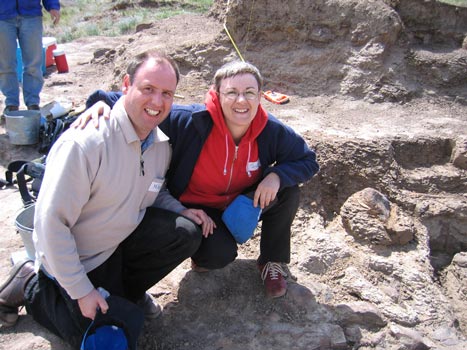Palaeontologists Take Steps to Preserve Important Dig Sites
Field Workers Intend to Increase Security at Dinosaur Dig Sites
Following a number of incidents of fossil thefts and deliberate vandalism from Canadian vertebrate fossil sites, scientists are taking steps to try to protect the precious fossils that they find. Dinosaur fossils can take many months or even years to be excavated and removed from a dig site. In many cases, each fragment of bone or piece of a tooth has to be carefully excavated and then protected with glues and resins before they can be taken from the location.
This painstaking process can take many hundreds of man hours to complete and as a result many fossils are only partially mapped and prepared in each season. The site is often carefully covered over so that palaeontologists can return to the area to complete their work later on that year or even in subsequent years.
Take Steps to Preserve Dig Sites
These locations, although very often to be found in remote areas attract trophy hunters and smugglers who are keen to remove fossils so that they can be sold illegally. However, some fossils have been deliberately vandalised as they lie in the ground awaiting further excavation work.
A Dinosaur Excavation in Alberta
Picture credit: Everything Dinosaur
Hadrosaurus Specimen Destroyed
It was reported that an eight-metre-long, duck-billed dinosaur specimen found in the Pipestone Creek area near Grande Prairie in north-western Alberta, Canada was smashed up and virtually destroyed a couple of months ago. This follows on from a number incidents reported to the Royal Canadian Mounted Police about dinosaur fossil thefts and damage to vertebrate fossils as they lie in their fossil locations.
To read more about the Pipestone Creek incident: Vandals in Alberta damage Duck-Billed Dinosaur Fossils.
Palaeontologists and field teams are now trying to work together to help protect their rare and delicate fossil finds. The problem is most palaeontology is carried out on a small budget, usually money allocated to a dig site from the bursar of a Natural History Museum. Often there are simply not the resources available to mount video security, infra-red cameras or to employ security staff twenty-four hours a day.
Scientists have requested that the land owners where fossils have been found, keep a close look out for trespassers or suspicious activity in the area. Their vigilance can help prevent attacks on the fossil finds. Volunteers have been called for in some areas to help deter thefts and acts of vandalism by getting people to camp out close to the site. Although, museum staff try their best to protect a location, the presence of local volunteers camping nearby would deter all but the most determined attacker.
Palaeontologists Keep Dig Sites Secret
One of the best ways to protect a new fossil discovery is to keep it a secret. By limiting the number of people who are informed of a dinosaur fossil discovery, scientists hope to minimise the risk that this information might fall into the wrong hands and lead to site damage or theft.
Public education can help to reduce the problem. In many countries, including Canada, the taking of fossil material or other artefacts is illegal and fines in excess of $40,000 Canadian dollars may be levied or even a term in prison. Palaeontologists believe that the vandalism may not be a deliberate attempt to destroy the fossils but the botched efforts of amateurs trying to steal the fossils either as souvenirs or to sell on.
For models of hadrosaurs and other North American dinosaurs: Models of North American Dinosaurs and Other Prehistoric Animals (Safari Ltd).


